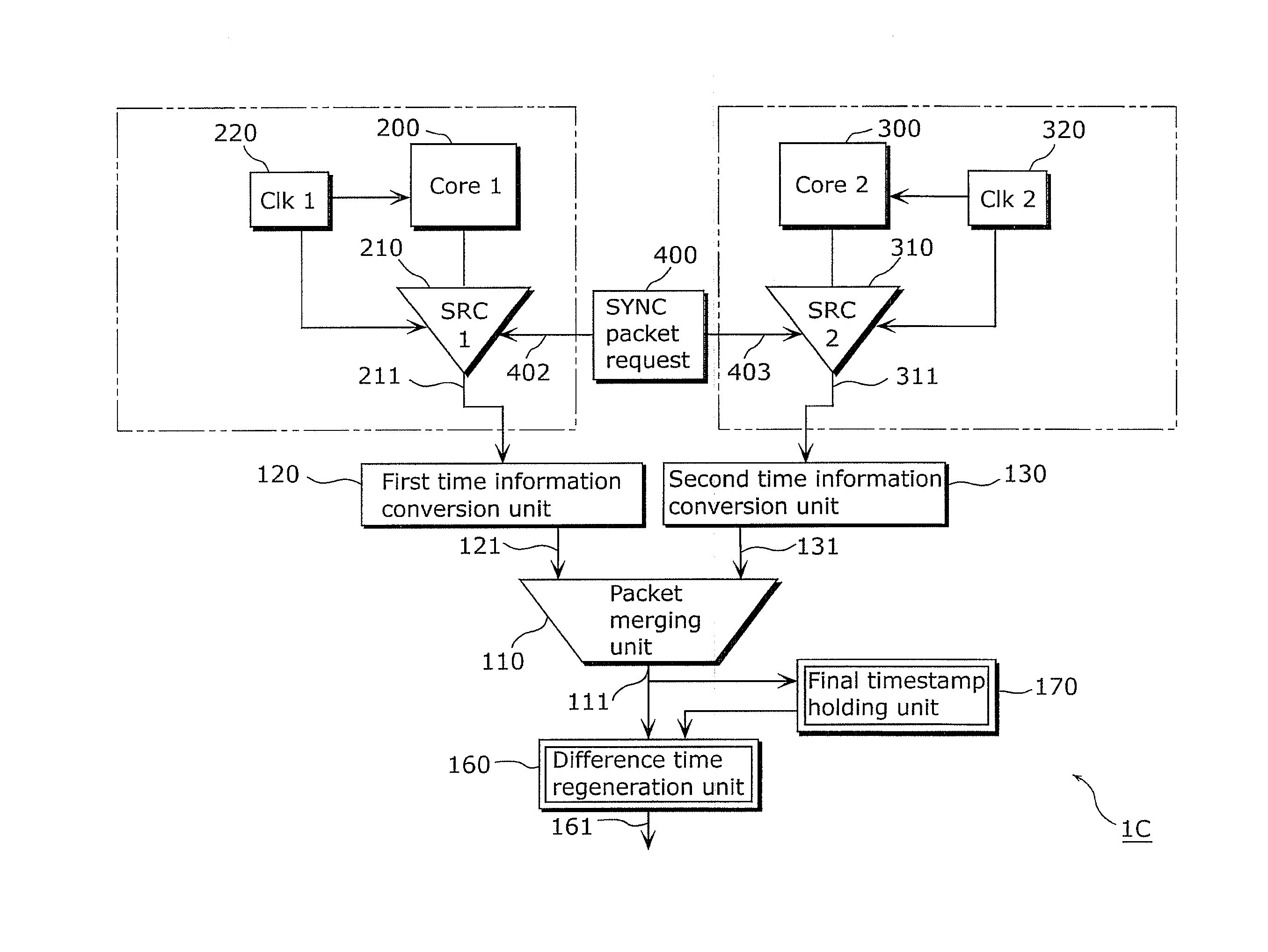Data processing device and method
a data processing and data technology, applied in the field of data processing devices, can solve the problems of trace buffer overflow, and insufficient bandwidth allocated for trace outputting compared to the bandwidth required, so as to reduce the overhead of trace data obtained, the effect of further reducing overhead
- Summary
- Abstract
- Description
- Claims
- Application Information
AI Technical Summary
Benefits of technology
Problems solved by technology
Method used
Image
Examples
embodiment 1
[0036]FIG. 1 is a diagram showing a configuration of an LSI 1 in Embodiment 1.
[0037]FIG. 1 illustrates the configuration of the LSI 1 which performs packet merging after converting the time information items of trace data sources of plural cores.
[0038]Here, the first trace data source 210 operates according to the first local clock 220, and outputs trace information items (first trace information items) from a first processor core 200 together with time information items (first time information items) measured according to the first local clock 220. The second trace data source 310 operates according to the second local clock 320, and outputs trace information items (second trace information items) from a second processor core 300 together with time information items (second time information items) measured according to the second local clock 320.
[0039]The first trace packet (trace information item) 211 from the first trace data source 210 is inputted to the packet merging unit 110 ...
embodiment 2
[0062]FIG. 2 is a diagram showing a configuration of an LSI 1A in Embodiment 2.
[0063]FIG. 2 shows the configuration of Embodiment 2, and shows that, in addition to the configuration in FIG. 1, a synchronization packet requesting unit 400 inputs synchronization packet requests (request signal 402, request signal 403) to each of the trace data sources.
[0064]The synchronization packet requesting unit 400 which requests the generation of a synchronization packet (see synchronization packet y1 and so on in FIG. 5) to the respective trace data sources (the first trace data source 210 and the second trace data source 310) is further added to the LSI 1 in Embodiment 1. Then, upon being requested for a synchronization packet by the synchronization packet requesting unit 400, each of the first trace data source 210 and second trace data source 310 inserts a synchronization packet into the trace data (first source stream 211A and so on in FIG. 5) to be outputted by such trace data source.
[0065...
embodiment 3
[0078]FIG. 6 is a diagram showing respective streams in Embodiment 3.
[0079]The examples in Embodiments 1 and 2 describe the case where, in the respective trace data sources, the local timestamps (the first time information item and the second time information item) are provided as elapsed times. In contrast, the local timestamp may be the difference time from a time measured using a local clock (see LTS value of first source stream 211B, and so on, in the top stage in FIG. 6).
[0080]When the time information items of the trace information items of the trace data source are provided as difference times, each of the first time information conversion unit 120 and the second time information conversion unit 130 adds up the present difference time and the respective past different times, and converts the present difference time into an elapsed time. After performing such conversion, each of the first time information conversion unit 120 and the second time information conversion unit 130 ...
PUM
 Login to View More
Login to View More Abstract
Description
Claims
Application Information
 Login to View More
Login to View More - R&D
- Intellectual Property
- Life Sciences
- Materials
- Tech Scout
- Unparalleled Data Quality
- Higher Quality Content
- 60% Fewer Hallucinations
Browse by: Latest US Patents, China's latest patents, Technical Efficacy Thesaurus, Application Domain, Technology Topic, Popular Technical Reports.
© 2025 PatSnap. All rights reserved.Legal|Privacy policy|Modern Slavery Act Transparency Statement|Sitemap|About US| Contact US: help@patsnap.com



